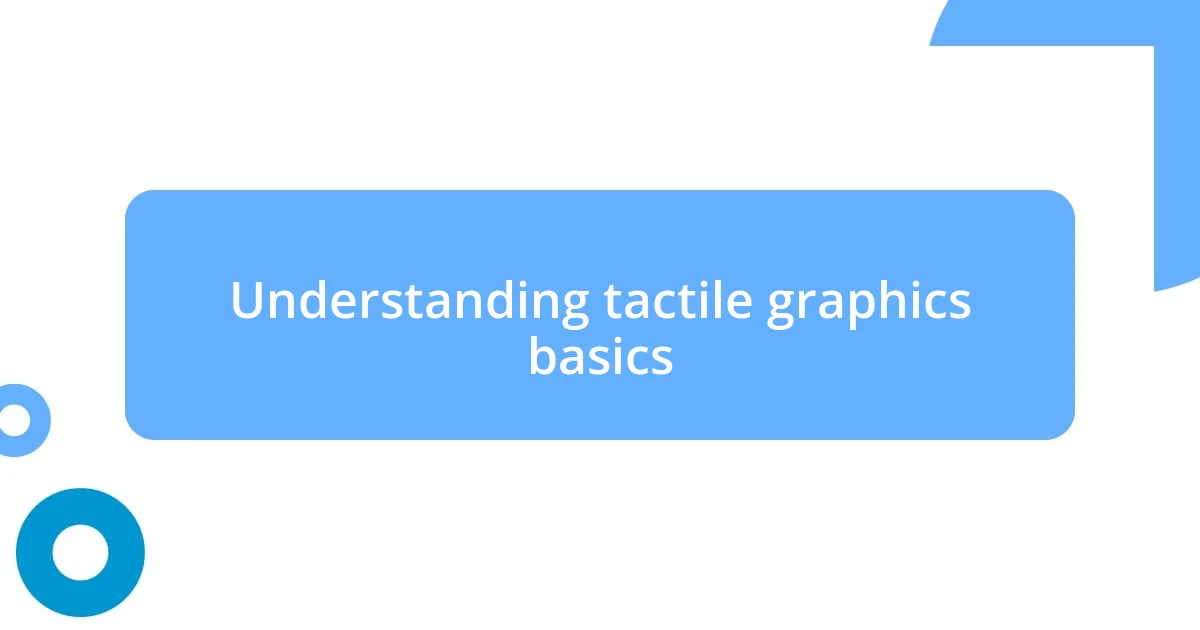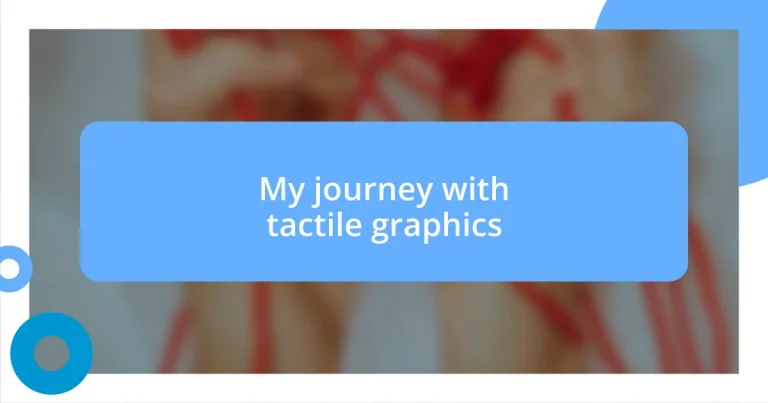Key takeaways:
- The author’s initial encounter with tactile graphics ignited a passion for exploring how touch-based learning can enhance engagement and understanding.
- Choosing appropriate materials is crucial for creating effective tactile graphics, as they significantly influence the user’s sensory experience and connection to the information.
- Incorporating tactile graphics in education fosters emotional connections and collaboration, transforming learning into an interactive, engaging exploration.

My initial interest in graphics
I vividly remember the first time I held a tactile graphic. It was during a classroom demonstration when the teacher handed me a raised-line map. The excitement I felt as my fingers traced the contours of mountains and rivers was electric—how could something so simple be so fascinating?
As I explored that map, my curiosity blossomed. Why had I never encountered graphics designed for touch before? This was a new world waiting to be discovered. The thrill of learning by feeling ignited a spark within me, leading to deeper questions about how tactile graphics could change the way people engage with information.
Each experience with tactile graphics was like unraveling a mystery, beckoning me to decode its secrets. I recall creating my first tactile diagram; the pride I felt was immense! It was then that I realized graphics weren’t just for sight—they were a language of their own, conveying ideas and emotions through touch. How could I not dive deeper into this captivating realm?

Understanding tactile graphics basics
Understanding tactile graphics basics is essential for grasping their significance in education and accessibility. Essentially, these graphics use raised lines and textures to represent information visually and tactually, allowing individuals with visual impairments to interact with content. From my experience, I’ve realized that the tactile feedback you receive makes information not only accessible but also memorable. When I first learned to read tactile graphics, I felt like I was connecting with the information in a whole new way—it was as if the content was coming alive beneath my fingers.
Tactile graphics can be quite varied in complexity, ranging from simple shapes to detailed maps or diagrams. In my early days of exploring tactile graphics, I remember how challenging it was to interpret a detailed tactile map. At times, I felt overwhelmed by the intricate details I was supposed to decipher. However, with practice and guidance, I found that every bump and line slowly revealed a treasure trove of knowledge, profoundly enhancing my spatial understanding. The struggle made each success even sweeter, reinforcing my love for this unique form of representation.
The creation of tactile graphics often involves a combination of art and science. I’ve had moments where I experimented with different materials, discovering how the texture can change a reader’s experience. For instance, using different types of paper or plastic can create varying levels of tactile sensation, altering the reader’s interpretation. It’s a fascinating process, and I still feel a rush of joy when I create something tactile that others can engage with.
| Aspect | Description |
|---|---|
| Definition | Tactile graphics utilize raised lines and textures to convey information for touch. |
| Complexity | Vary from simple shapes to intricate maps and diagrams, enhancing understanding. |
| Creation Materials | Materials like paper or plastic can impact the tactile experience significantly. |

Choosing the right materials
Choosing the right materials for tactile graphics is crucial in delivering a powerful sensory experience. When I first delved into the world of creating tactile graphics, I experimented with a range of materials, and I quickly learned how essential this choice is. For instance, I once used a rough-textured paper for a project, thinking it would add an interesting element. However, it ended up being too abrasive and numbing for delicate fingers to navigate. That experience taught me to prioritize user comfort over creative flair.
Here are some essential materials I often consider:
- Braille Paper: This has a fine texture, making it perfect for raised lines without compromising the smoothness needed for clarity.
- Foam Sheets: These provide a variety of thicknesses, allowing for a different tactile experience, especially in distinguishing various elements in complex graphics.
- Specialty Plastics: They can be used for more durable projects and create varying degrees of tactile feedback, enhancing the overall interaction.
- String or Cord: This can be utilized to create raised lines for maps or diagrams, bringing a unique element of flexibility and recognize the importance of texture.
Selecting the right materials not only enhances the tactile quality but also defines how well the audience connects with the information. I remember crafting a tactile graphic for a science project, where I used a soft foam for a volcano. The kids loved how they could feel every dip and rise, and it became a memorable experience. The joy on their faces as they felt the shapes come to life was incredibly rewarding. These moments keep inspiring me to hone my material choices with every new project I embark on.

Techniques for creating tactile images
Creating tactile images requires a thoughtful approach, and I often emphasize that the technique used can significantly impact the final product. One method I enjoy is embossing, which involves pressing a design onto a material to create raised elements. I remember the first time I embossed a tactile image of a tree; the way the branches and leaves stood out was thrilling. It not only changed how I interacted with the image but also how others experienced it. Have you ever felt that sense of accomplishment when your hands uncovered something new? It’s a magical moment.
Another technique that I’ve explored is using texture to convey meaning. Different textures can represent various elements, and I think that’s where creativity truly shines. For instance, I used sandpaper for rough terrains in a tactile landscape and cotton for soft clouds. It amazed me how much a simple change in texture could transform a user’s understanding. When I first introduced this concept in a workshop, participants were astonished at how their tactile experiences aligned with their visual interpretations. It made me realize just how crucial our choices are in crafting engaging and memorable tactile graphics.
Lastly, layering materials effectively can create dynamic tactile images. I learned this firsthand while developing a multi-layered diagram for a biology lesson. Each layer represented a different aspect of the anatomy, and I felt a sense of joy as I stacked them, watching the complexity unfold. Have you ever completed a puzzle and felt a rush of satisfaction as the pieces fit together? That’s exactly how layering works; it enhances comprehension and allows tactile learners to delve deeper into the information. My ability to mix different heights and textures continues to evolve, and I can’t wait to see how it shapes my future projects.

Using tactile graphics in education
Using tactile graphics in education has opened up transformative avenues for learning. In a recent workshop, I had the opportunity to guide a group of teachers on how to create tactile maps. One teacher expressed concern about how her visually impaired students would connect with geography. After we crafted a tactile world map together, I witnessed her excitement when her students began exploring it independently. It was a reminder of how tactile experiences can bridge gaps and enrich understanding.
I often think about the emotional responses that come from tactile learning. There was a moment when I introduced tactile graphics in a history class. As students traced a tactile outline of ancient structures, their faces lit up with curiosity and engagement. They asked questions, and the conversation flowed naturally. Isn’t it fascinating how touching something can spark inquiry and connection? This embodied interaction fosters a deeper connection to the material, making learning not just an intellectual exercise but an exploration of the senses.
Another aspect I cherish is facilitating collaboration through tactile graphics. I recall a project where students worked in pairs to create a tactile timeline of events. They not only learned about the history but also practiced teamwork and communication. Watching them bounce ideas off each other while feeling the textures and shapes was truly heartwarming. Have you ever seen teamwork thrive when creativity flows? That’s what tactile graphics can achieve, transforming the classroom into an inspiring environment where every learner can thrive.

Sharing my tactile graphic projects
I love showcasing my tactile graphic projects, especially because each one tells its own story. For instance, I once created a tactile interpretation of a famous painting, embedding various textures to represent different elements in the artwork. Seeing individuals engage with the piece, their fingers tracing the contours and discovering details that would otherwise go unnoticed, was incredibly rewarding. It struck me how tactile art can evoke emotions in ways that are distinct from visual art, creating a deeper connection for the viewer.
One project I’m particularly proud of involved designing tactile flashcards for learning animal classifications. Each card featured not only the raised outline of the animal but also specific textures, like smooth foil for birds or rough fabric for mammals. The excitement I felt when students identified the animals based on touch alone fueled my passion. Have you ever witnessed the moment when someone connects with learning on a personal level? That sense of connection is palpable and underscores just how impactful tactile graphics can be.
Another memorable project was a tactile board representing the solar system. I layered different materials to signify the varying sizes and textures of planets, allowing users to feel the differences as they explored. I can still recall a child’s face lighting up when they discovered how much smoother Jupiter felt compared to the rough surface of Mars. It’s moments like these that reaffirm my belief in the power of tactile experiences to captivate curiosity and spark a love for knowledge. Isn’t it incredible how something as simple as touch can transform learning into an adventure?














